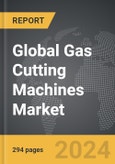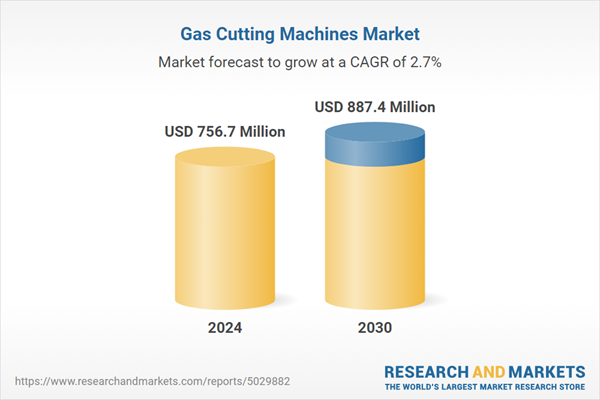The global market for Gas Cutting Machines was valued at US$756.7 Million in 2024 and is projected to reach US$887.4 Million by 2030, growing at a CAGR of 2.7% from 2024 to 2030. This comprehensive report provides an in-depth analysis of market trends, drivers, and forecasts, helping you make informed business decisions.
Global Gas Cutting Machines Market - Key Trends and Drivers Summarized
Why Are Gas Cutting Machines Indispensable for Modern Industry?
Gas cutting machines play an essential role in modern manufacturing, construction, and metalworking industries. These machines are designed to cut through metals like steel, aluminum, and iron with precision and efficiency. But what makes gas cutting machines so vital in these industries? The answer lies in their ability to handle heavy-duty cutting tasks where precision, speed, and cost-effectiveness are critical. Using a mixture of gases such as oxygen and acetylene or propane, gas cutting machines apply intense heat to melt and cut through metals. This method, known as oxy-fuel cutting, has been a standard in industries ranging from shipbuilding to automotive manufacturing for decades. Gas cutting machines are capable of cutting thick metal plates that would be impossible or time-consuming to process with other methods. Their versatility and adaptability make them invaluable in fabrication shops, construction sites, and large-scale industrial operations. Beyond their core cutting function, these machines also offer the advantage of portability, allowing workers to bring powerful cutting technology directly to job sites where metal cutting is required. As industries evolve, gas cutting machines continue to be an indispensable part of metal fabrication and construction.How Is Technology Enhancing the Efficiency and Precision of Gas Cutting Machines?
Technological innovations are transforming gas cutting machines, making them more precise, efficient, and user-friendly. One of the key advancements is the integration of CNC (Computer Numerical Control) systems into gas cutting machines. CNC technology allows operators to program complex cutting patterns with high precision, reducing human error and ensuring consistent results. This level of automation not only improves the quality of cuts but also increases production speed, making it ideal for industries that require large-scale fabrication. Another major advancement is in gas regulation systems. Modern gas cutting machines now come equipped with automatic gas flow controls that optimize the mixture of gases for different materials and cutting thicknesses, ensuring cleaner cuts with minimal waste. Plasma-assisted gas cutting is another leap forward, allowing for faster and more precise cuts, especially in metals like stainless steel and aluminum. Furthermore, advancements in material science have led to the development of more durable cutting nozzles and torches, extending the lifespan of the machines and reducing downtime. These innovations collectively improve both the operational efficiency and the precision of gas cutting machines, making them indispensable in industries that demand high-performance cutting solutions.Why Are Gas Cutting Machines Becoming More User-Friendly and Sustainable?
As industrial processes evolve, there is an increasing focus on making gas cutting machines more user-friendly and sustainable. Safety has always been a primary concern with gas cutting, given the flammable nature of gases like acetylene and propane. To address this, manufacturers are incorporating advanced safety features such as automatic shut-off systems, flame arrestors, and better heat-resistant materials. These improvements not only enhance operator safety but also reduce the likelihood of accidents, making gas cutting machines more accessible to a wider range of users, including small and medium-sized enterprises. Ergonomics is another area where significant strides have been made. Lighter, more compact designs, along with improved handle grips and adjustable torches, allow operators to work longer without experiencing fatigue. On the sustainability front, there is a growing trend toward the use of alternative, more eco-friendly gases like hydrogen or natural gas, which reduce emissions and lower the environmental impact of cutting processes. Additionally, advancements in energy efficiency are helping to lower the amount of fuel required for cutting, reducing both operating costs and carbon footprints. These improvements make gas cutting machines not only safer and easier to use but also more aligned with the increasing demand for environmentally responsible industrial practices.What Factors Are Driving the Growth of the Gas Cutting Machine Market?
The growth in the gas cutting machine market is driven by several factors, including technological advancements, increased industrialization, and the rising demand for more efficient and sustainable cutting solutions. First, the integration of automation technologies such as CNC controls has revolutionized the metal fabrication industry, allowing for more precise and complex cutting tasks with minimal manual intervention. This automation reduces labor costs and increases production rates, which is particularly beneficial for industries like automotive, shipbuilding, and construction, where large-scale metal cutting is required. Second, the rapid industrialization in emerging economies is fueling demand for gas cutting machines, as manufacturing and construction activities surge. Developing countries in Asia and Africa are witnessing robust growth in their industrial sectors, creating new opportunities for gas cutting machine manufacturers to expand their market presence. Third, the growing focus on sustainability is driving the adoption of gas cutting machines that use alternative fuels and energy-efficient designs, reducing both emissions and operational costs. These eco-friendly machines are becoming increasingly popular in industries that are under pressure to meet environmental regulations and reduce their carbon footprints. Finally, the rising need for high-quality metal fabrication in sectors such as aerospace, defense, and heavy machinery is creating demand for advanced gas cutting solutions that can handle complex tasks with precision and speed. Collectively, these factors are contributing to the steady growth of the gas cutting machine market, as industries continue to seek out innovative, cost-effective, and sustainable cutting technologies.Report Scope
The report analyzes the Gas Cutting Machines market, presented in terms of market value (US$ Thousand). The analysis covers the key segments and geographic regions outlined below.Segments
Type (Stationary, Portable).Geographic Regions/Countries
World; United States; Canada; Japan; China; Europe (France; Germany; Italy; United Kingdom; Spain; Russia; and Rest of Europe); Asia-Pacific (Australia; India; South Korea; and Rest of Asia-Pacific); Latin America (Argentina; Brazil; Mexico; and Rest of Latin America); Middle East (Iran; Israel; Saudi Arabia; United Arab Emirates; and Rest of Middle East); and Africa.Key Insights:
- Market Growth: Understand the significant growth trajectory of the Stationary Gas Cutting Machines segment, which is expected to reach US$601.9 Million by 2030 with a CAGR of a 2.6%. The Portable Gas Cutting Machines segment is also set to grow at 2.8% CAGR over the analysis period.
- Regional Analysis: Gain insights into the U.S. market, valued at $203.0 Million in 2024, and China, forecasted to grow at an impressive 3.9% CAGR to reach $170.0 Million by 2030. Discover growth trends in other key regions, including Japan, Canada, Germany, and the Asia-Pacific.
Report Features:
- Comprehensive Market Data: Independent analysis of annual sales and market forecasts in US$ Million from 2024 to 2030.
- In-Depth Regional Analysis: Detailed insights into key markets, including the U.S., China, Japan, Canada, Europe, Asia-Pacific, Latin America, Middle East, and Africa.
- Company Profiles: Coverage of major players such as Ador Welding Ltd., ARCBRO CNC CUTTING MACHINE, ESAB, Esprit Automation Ltd., Haco NV and more.
- Complimentary Updates: Receive free report updates for one year to keep you informed of the latest market developments.
Why You Should Buy This Report:
- Detailed Market Analysis: Access a thorough analysis of the Global Gas Cutting Machines Market, covering all major geographic regions and market segments.
- Competitive Insights: Get an overview of the competitive landscape, including the market presence of major players across different geographies.
- Future Trends and Drivers: Understand the key trends and drivers shaping the future of the Global Gas Cutting Machines Market.
- Actionable Insights: Benefit from actionable insights that can help you identify new revenue opportunities and make strategic business decisions.
Key Questions Answered:
- How is the Global Gas Cutting Machines Market expected to evolve by 2030?
- What are the main drivers and restraints affecting the market?
- Which market segments will grow the most over the forecast period?
- How will market shares for different regions and segments change by 2030?
- Who are the leading players in the market, and what are their prospects?
Some of the 41 major companies featured in this Gas Cutting Machines market report include:
- Ador Welding Ltd.
- ARCBRO CNC CUTTING MACHINE
- ESAB
- Esprit Automation Ltd.
- Haco NV
- Harris Products Group
- Hornet Cutting Systems
- Koike Aronson, Inc.
- Messer Cutting Systems GmbH
- Nissan Tanaka Corporation
- Shangai Welding & Cutting Tool Works
- SteelTailor Ltd.
- Voortman Steel Machinery BV
Table of Contents
I. METHODOLOGYII. EXECUTIVE SUMMARY2. FOCUS ON SELECT PLAYERSIII. MARKET ANALYSISIV. COMPETITION
1. MARKET OVERVIEW
3. MARKET TRENDS & DRIVERS
4. GLOBAL MARKET PERSPECTIVE
UNITED STATES
CANADA
JAPAN
CHINA
EUROPE
FRANCE
GERMANY
ITALY
UNITED KINGDOM
SPAIN
RUSSIA
REST OF EUROPE
ASIA-PACIFIC
AUSTRALIA
INDIA
SOUTH KOREA
REST OF ASIA-PACIFIC
LATIN AMERICA
ARGENTINA
BRAZIL
MEXICO
REST OF LATIN AMERICA
MIDDLE EAST
IRAN
ISRAEL
SAUDI ARABIA
UNITED ARAB EMIRATES
REST OF MIDDLE EAST
AFRICA
Companies Mentioned (Partial List)
A selection of companies mentioned in this report includes, but is not limited to:
- Ador Welding Ltd.
- ARCBRO CNC CUTTING MACHINE
- ESAB
- Esprit Automation Ltd.
- Haco NV
- Harris Products Group
- Hornet Cutting Systems
- Koike Aronson, Inc.
- Messer Cutting Systems GmbH
- Nissan Tanaka Corporation
- Shangai Welding & Cutting Tool Works
- SteelTailor Ltd.
- Voortman Steel Machinery BV
Table Information
| Report Attribute | Details |
|---|---|
| No. of Pages | 294 |
| Published | April 2025 |
| Forecast Period | 2024 - 2030 |
| Estimated Market Value ( USD | $ 756.7 Million |
| Forecasted Market Value ( USD | $ 887.4 Million |
| Compound Annual Growth Rate | 2.7% |
| Regions Covered | Global |









